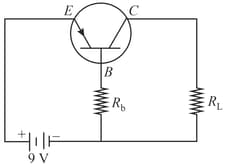Transistor Action and Its Characteristics
Transistor Action and Its Characteristics: Overview
This topic covers concepts such as junction transistor, symbol of a transistor, size of base, emitter and collector, doping concentration of base, emitter and collector, and common base configuration.
Important Questions on Transistor Action and Its Characteristics
An n – p – n transistor can be used to produce self-sustained oscillations.
The given statement is true of false:
If is the emitter current, the base current and the collector current of a transistor, then which of the following statements are NOT TRUE?
(i)
(ii)
(iii)
(iv)
The collector current is in transistor. If electrons emitted reach the collector then:
Find the value of the resistor , if the base current in the transistor circuit shown in the figure is .

The collector current that is obtained in a self biased transistor is _____
The correct relation between in a transistor is
Define beta current gain of the transistor.
Alpha current gain is defined for which of the following configuration:
Define alpha current gain of a transistor.
Output is taken between the emitter and the base of a transistor in a common-collector configuration of an amplifier.
Show the circuit diagram for the biasing of a P-N-P transistor in common collector configuration.
Draw the circuit diagram for the common collector configuration of N-P-N transistor as an amplifier.
Draw the symbol of an N-P-N transistor.
When transistors are used in digital circuits they usually operate in:
________ segment supplies the majority charge carriers for the current flow through a transistor
The base region in a p-n-p transistor is obtained by doping an intrinsic semiconductor with
The moderate sized and heavily doped region of a transistor is
The current gain for a transistor working as common-base amplifier is If the emitter current is then the base current is ________
In an NPN transistor circuit, the collector current is If of the emitted electrons reach the collector, the emitter current and base current are given by
For a common emitter configuration, if and have their usual meanings, the correct relationship between and is:
